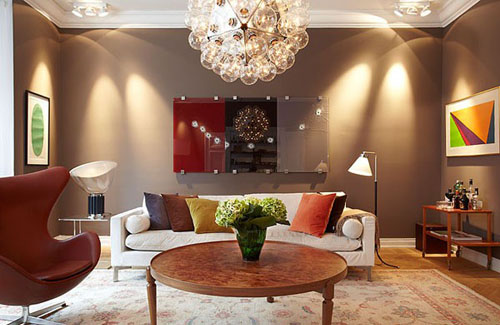
Lighting Can Make A Room
Lighting is an essential component to the décor of any room, influencing the way people perceive the space by making it seem larger or smaller. Lighting can also give feedback about what a room is used for; it makes sense for a cozy den to be a little dark, but in the living room, darkness may leave people feeling shut in. Lighting has to do with a lot more than windows and lamps, and giving a dim room an open, glowing effect can come down to a few interesting tricks.
Paint Makes a Difference
If your room seems a little lackluster, consider repainting the walls and ceiling in a color that reflects light. Though it may be tempting to paint rooms with your favorite rich, deep colors, these colors absorb light from the outside and from inside fixtures, making the room appear dark and cramped. Painting a dingy room with a coat or two of reflective eggshell paint in white, off-white, or pale yellow can do wonders, transforming it into a bright, inviting environment. Matte paints are less reflective, so they’re generally not a good choice for rooms that need to be spruced up. If you still want a personalized touch, consider using those rich colors for baseboards and trim.

Distribute Your Light Sources
Selecting the location and focus of your light sources can do wonders for a room. In rooms like the kitchen, which have a few focus points that require clear lighting, consider installing a set of fixtures above countertops and islands. The sink is also a good place to put a fixture; most sinks are already set up next to a window, but extra lighting in the evening can make all the difference. Needless to say, the same goes for bathroom sinks.
On the other hand, a living room or bedroom might need less focused lighting than a kitchen, requiring instead that lighting be diffuse. Instead of having overhead lights, which can be overbearing or reflect disruptively off of surfaces like TVs, computer screens and coffee tables, use cove or valance lighting with soft yellow bulbs. You’ll also need task lighting around the room where people might read, watch TV, or have a conversation. That type of lighting is best arranged with table lamps, which are versatile and can be set up at heights that match the needs of the people using them.
Lighting can also generally be used to highlight objects of visual interest; consider ceiling fixtures that illuminate bookcases, tables and art objects. A sense of dynamic brightness can come from paintings and books just as easily as posters and sculptures.
Make the Best of Natural Light
If you have great windows in a room, make best use of them! This might involve reshuffling the setup of a room. Especially in living rooms and bedrooms, make sure that nothing gets in the way of light from the window. Crowding a window with an adjacent shelf, dresser, or wardrobe can limit the light from spreading throughout the room. On the other hand, a bed might be ideally placed next to a window if you want to feel surrounded by light in the morning.
As always, don’t forget about mirrors! Mirrors can be set up unobtrusively to reflect light from windows or from light fixtures. They also make the room seem larger, since they give the illusion of depth. Play with mirrors to see how they work in the room you’re trying to brighten up; positioning is key, but will depend heavily on the existing layout.
Ron Nathan, founder and President of Ron Nathan Interior Design Group, is an innovative and accomplished interior designer. Since 1974, his firm has been known for their signature look which is refreshing, imaginative, luxurious and comfortable.
